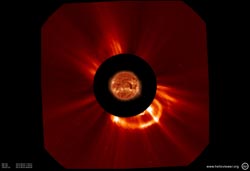NASA Spacecraft Capture an Earth Directed Coronal Mass Ejection

The SOHO LASCO C2 instrument captured this image of the Earth-directed CME. SOHO's coronographs are able to take images of the solar corona by blocking the light coming directly from the Sun with an occulter disk. The location of the actual sun is shown with an image taken by SDO. Image Credit: ESA & NASA/SOHO, SDO<br>
These particles cannot travel through the atmosphere to harm humans on Earth, but they can affect electronic systems in satellites and on the ground.
Experimental NASA research models, based on observations from NASA’s Solar Terrestrial Relations Observatory show that the CME left the sun at speeds of around 570 miles per second, which is a fairly typical speed for CMEs.
Earth-directed CMEs can cause a space weather phenomenon called a geomagnetic storm, which occurs when they funnel energy into Earth's magnetic envelope, the magnetosphere, for an extended period of time. The CME’s magnetic fields peel back the outermost layers of Earth's fields changing their very shape. In the past, geomagnetic storms caused by CMEs of this strength have usually been mild.
Magnetic storms can degrade communication signals and cause unexpected electrical surges in power grids. They also can cause aurora.
NOAA's Space Weather Prediction Center (http://swpc.noaa.gov) is the U.S. government's official source for space weather forecasts, alerts, watches and warnings.
Updates will be provided if needed.
Susan Hendrix
NASA's Goddard Space Flight Center, Greenbelt, Md.
Media Contact
All latest news from the category: Physics and Astronomy
This area deals with the fundamental laws and building blocks of nature and how they interact, the properties and the behavior of matter, and research into space and time and their structures.
innovations-report provides in-depth reports and articles on subjects such as astrophysics, laser technologies, nuclear, quantum, particle and solid-state physics, nanotechnologies, planetary research and findings (Mars, Venus) and developments related to the Hubble Telescope.
Newest articles

Silicon Carbide Innovation Alliance to drive industrial-scale semiconductor work
Known for its ability to withstand extreme environments and high voltages, silicon carbide (SiC) is a semiconducting material made up of silicon and carbon atoms arranged into crystals that is…

New SPECT/CT technique shows impressive biomarker identification
…offers increased access for prostate cancer patients. A novel SPECT/CT acquisition method can accurately detect radiopharmaceutical biodistribution in a convenient manner for prostate cancer patients, opening the door for more…

How 3D printers can give robots a soft touch
Soft skin coverings and touch sensors have emerged as a promising feature for robots that are both safer and more intuitive for human interaction, but they are expensive and difficult…





















